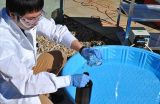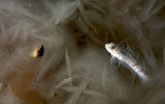(Press-News.org) An analysis of 70 studies finds that use of the diagnostic imaging procedure of fludeoxyglucose F18 (FDG)-positron emission tomography (PET) combined with computed tomography (CT) may not reliably distinguish benign disease from lung cancer in populations with endemic (high prevalence) infectious lung disease compared with nonendemic regions, according to a study in the September 24 issue of JAMA.
Depending on the risk for cancer, diagnostic guidelines suggest or recommend FDG combined with PET as a noninvasive test to assess the risk of cancer or benign disease, according to background information in the article.
Stephen A. Deppen, Ph.D., of the Tennessee Valley Healthcare System and Vanderbilt University Medical Center, Nashville, and colleagues conducted a meta-analysis to examine the accuracy of FDG-PET to diagnose lung lesions in regions with locally endemic infectious lung diseases. The researchers identified 70 studies that met criteria for inclusion in the analysis. Studies reported on a total of 8,511 nodules; 5,105 (60 percent) were malignant.
Pooled sensitivity of FDG-PET for diagnosing lung cancer was 89 percent and pooled specificity was 75 percent. There was a 16 percent lower average adjusted specificity in regions with endemic infectious lung disease (61 percent) compared with nonendemic regions (77 percent). Lower specificity was observed when the analysis was limited to rigorously conducted and well-controlled studies.
"FDG-PET for the diagnosis of lung cancer in patients who reside in a region with significant endemic infectious lung disease should be recognized as having lower specificity than previously reported. Knowledge of this reduction in specificity should limit the use of FDG-PET to diagnose lung cancer unless substantial institutional expertise in FDG-PET interpretation has been proven. Should low-dose CT screening for lung cancer become the diagnostic standard, knowledge of FDG-PET/CT performance is even more critical because the vast majority of indeterminate lung nodules detected through screening are benign," the authors write.
INFORMATION:(doi:10.1001/jama.2014.11488; Available pre-embargo to the media at http://media.jamanetwork.com)
Editor's Note: Please see the article for additional information, including other authors, author contributions and affiliations, financial disclosures, funding and support, etc.
Lung cancer test less effective in areas where infectious lung disease is more common
2014-09-23
ELSE PRESS RELEASES FROM THIS DATE:
Study questions accuracy of lung cancer screens in some geographic regions
2014-09-23
A new analysis of published studies found that FDG-PET technology is less accurate in diagnosing lung cancer versus benign disease in regions where infections like histoplasmosis or tuberculosis are common. Misdiagnosis of lung lesions suspicious for cancer could lead to unnecessary tests and surgeries for patients, with additional potential complications and mortality.
Histoplasmosis and other fungal diseases are linked to fungi that are often concentrated in bird droppings and are found in soils.
The study by investigators at Vanderbilt University and the Tennessee ...
Asteroid named for University of Utah makes public debut
2014-09-23
SALT LAKE CITY, Sept. 23, 2014 – What's rocky, about a mile wide, orbits between Mars and Jupiter and poses no threat to Earth?
An asteroid named "Univofutah" after the University of Utah.
Discovered on Sept. 8, 2008, by longtime Utah astronomy educator Patrick Wiggins, the asteroid also known as 391795 (2008 RV77) this month was renamed Univofutah by the International Astronomical Union's Minor Planet Center in Cambridge, Massachusetts.
"It's neat," Wiggins says. "There aren't too many other universities on the whole planet with asteroids named after them. So that ...
Does size matter? MRI imaging sheds light on athletes most at risk for severe knee injury
2014-09-23
The successful rise and fall of an athlete's moving body relies on an orchestrated response of bones, joints, ligaments and tendons, putting the many angles and intersecting planes – literally the geometry – of a critical part like a knee joint to the test. But it's more than just a footfall error at the root of one of the most devastating of sports injuries: the ACL or anterior cruciate ligament tear. In fact, size – of the femoral notch that sits at the center of the knee joint – and volume of the ACL combine to influence the risk of suffering a noncontact ACL injury. ...
Infant cooing, babbling linked to hearing ability, MU researcher finds
2014-09-23
COLUMBIA, Mo. – Infants' vocalizations throughout the first year follow a set of predictable steps from crying and cooing to forming syllables and first words. However, previous research had not addressed how the amount of vocalizations may differ between hearing and deaf infants. Now, University of Missouri research shows that infant vocalizations are primarily motivated by infants' ability to hear their own babbling. Additionally, infants with profound hearing loss who received cochlear implants to help correct their hearing soon reached the vocalization levels of their ...
Solar energy-driven process could revolutionize oil sands tailings reclamation
2014-09-23
Edmonton—Cleaning up oil sands tailings has just gotten a lot greener thanks to a novel technique developed by University of Alberta civil engineering professors that uses solar energy to accelerate tailings pond reclamation efforts by industry.
Instead of using UV lamps as a light source to treat oil sands process affected water (OSPW) retained in tailings ponds, professors Mohamed Gamal El-Din and James Bolton have found that using the sunlight as a renewable energy source treats the wastewater just as efficiently but at a much lower cost.
"We know it works, so now ...
Antifreeze proteins in Antarctic fish prevent both freezing and melting
2014-09-23
Antarctic fish that manufacture their own "antifreeze" proteins to survive in the icy Southern Ocean also suffer an unfortunate side effect, researchers funded by the National Science Foundation (NSF) report: The protein-bound ice crystals that accumulate inside their bodies resist melting even when temperatures warm.
"We discovered what appears to be an undesirable consequence of the evolution of antifreeze proteins in Antarctic notothenioid fish," said University of Oregon doctoral student Paul Cziko, who led the research with University of Illinois animal biology ...
NYU-Mount Sinai Beth Israel study explores drug users' opinions on genetic testing
2014-09-23
Genomic medicine is rapidly developing, bringing with its advances promises of individualized genetic information to tailor and optimize prevention and treatment interventions. Genetic tests are already guiding treatments of the human immunodeficiency virus (HIV) and hepatitis c virus (HPC), and emerging research is showing genetic variants may be used to screen for an individual's susceptibility to addiction to a substance, and even inform treatments for addiction.
While there appear to be many benefits inherent in the development of this field and related research, ...
Slight alterations in microRNA sequences hold more information than previously thought
2014-09-23
(PHILADELPHIA) – Researchers have encountered variants or isoforms in microRNAs (miRNAs) before, but assumed that these variants were accidental byproducts. A recent study, published in the journal Oncotarget this month, shows that certain so called isomiRs have abundances that depend on geographic subpopulations and gender and that the most prevalent variant of a given miRNA may not be the one typically listed in the public databases.
"This study shows that microRNA isoforms are much more common than we had previously assumed. The fact that some isoforms are shared by ...
Mefloquine fails to replace SP for malaria prevention during pregnancy
2014-09-23
In this issue of PLOS Medicine, Clara Menendez from the Barcelona Institute for Global Health (ISGlobal), Spain, and colleagues report results from two large randomized controlled trials conducted in Africa to test an alternative drug for malaria prevention in HIV-negative and HIV-positive pregnant women.
Pregnant women and their unborn children are at a high risk for complications from malaria infection, and finding new treatment options is important because the malaria parasites are becoming increasingly resistant to the existing WHO-recommended drug sulphadoxine-pyrimethamine ...
Patients accept false-positives to achieve diagnostic sensitivity
2014-09-23
OAK BROOK, Ill. (September 23, 2014) – Both patients and healthcare professionals believe diagnosis of extracolonic malignancy with screening computed tomography (CT) colonography greatly outweighs the potential disadvantages of subsequent radiologic or invasive follow-up tests precipitated by false-positive diagnoses, according to a new study published in the October issue of the journal Radiology.
Diagnostic tests used for cancer screening programs usually target a specific organ. However, when screening for colorectal cancer with CT colonography, abdominal and pelvic ...


